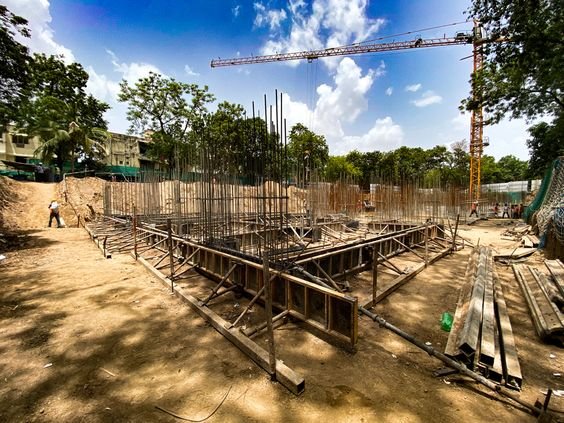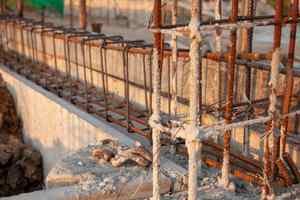In construction, a tie beam is a structural beam used to join together two columns at any level above ground. The term “tie”, referring to its function, is used to join together or “tie” two columns or other supports. This article will go over a variety of topics related to tie beams, including their design, uses, advantages, and more.
all about: i beam
Tie beam: What is it?

Source: Pinterest
A tie beam is a beam used to strengthen the connection between columns, rafters, or other structural members in a building’s upper stories. When a vertical part (the columns) on the foundation is uneven, the tie beams take on the role of a strap beam, bearing all the loads.
The roof truss, floor level, and plinth are the primary locations where tie beams are installed. They are unable to support any kind of vertical weight, such as walls or other structures. In addition to their primary function, tie beams can also be used as a tie element to prevent the differential settlement that might occur between footings based on the strata.
Tie beam: Composition
The tie beams are designed to bear the superimposed weight of the walls, which might be brick or blocks located above them, as well as the varied settlement load that the structure experiences. There is no limit to the height that your tie beams can be. It is possible to install tie beams on any level. The beams that are situated at the plinth level are referred to as plinth beams. They offer support for walls in addition to helping to keep soil in place.
The design of the tie beam will be determined by the amount of differential settlement that occurs in the foundation that was selected for the project. The design of the tie beam is dependent on the differential settlement. A differential settlement commonly occurs as a result of the non-uniform movement of the underlying soils (soil settlement at different rates). Differential settlement is calculated with the delta sign ∆. If delta represents the differential settlement, then this moment will be distributed across beam-column members based on their flexural stiffness.
Tie beam: Height
When the height of a column is more than 4 or 5 metres, it is common to practise advocating the use of a tie beam. However, the designer has to pay attention to the bending length of the column to ensure that the columns are not too thin.
see also about All you need to know about Pile Cap
Tie beam: Applications and benefits
- Tie beams are not responsible for carrying any floor loads; rather, they are used as length breakers for columns that support extremely high floors.
- They can withstand compression along the axial direction.
- They do not move from their location even when there are earthquake occurrences.
- They transport the weight from the rafter to the column. Under severe strains, a thin column can be prevented from buckling if it is supported by a tie beam.
- They are used to connect the pile caps and column footings. Tie Beams do this by retaining longitudinal bars, which prevents the concrete from moving while it is being poured.
- If there is the differential settlement, they are used as grade beams to distribute vertical loads via shear and moment forces.
- They are used as footings for walls, either on the inside or outside.
- They provide the function of grade beams above a pile foundation to link the pile caps and support structure that is located above.
Tie beam: Bar bending schedule for tie beams
- The primary objective of the bar bending schedule is to ascertain the amounts of reinforcement that are needed for the construction of the structure.
- Convection of information on the tie beam/strap beam reinforcement for the substructure is facilitated tremendously by the use of a Bar Bending Schedule for footings.
- It is important to determine whether or not the two footings will continue to be in the same line before setting up the tie beam.
- Strap beams are similar to tie beams, but instead of joining the two footings at right angles, strap beams attach them at an angle of their choosing. When there is a difference in level between two footings, a strap beam is employed.
- Specifically, the tie beam or the strap beam is positioned between the pile tops and the shallow foundations. The primary objective of these foundations is to ensure that all pile tops and shallow foundation reach the same level of minimal settlement.
- The main bars are the horizontal reinforcement bars that link one footing to another footing, while the stirrups are the name given to the vertical reinforcement bars (rings).
- The primary bars can be held in place more securely with the assistance of stirrups.
Tie beam: How to use column ties to achieve an ideal structural design?
To begin, the rods need to be straightened before ties can be made, and the diameters of the rods can be accurately maintained. The length of the rods that are used to make ties shouldn’t be any less than 10 millimetres at the very least.
Cutting and bending the rods should be done carefully, according to the specifications that are stated in the designs; otherwise, the material will be squandered.
You need to contact the design engineers so that they can ensure that the right specification and spacing of the connections are maintained.
Tie beam: How can they endure an earthquake?
The following attention to detail is required for the ties to endure an earthquake:
- The hook on the tie should be curved at an angle of 135 degrees. It is recommended that the head portion of the ties be stretched up to a 10d. It should be 100 mm, which is equal to 4 inches, for a rod that is 10 mm.
- Protecting the connections that are positioned in the middle region of the member against earthquakes is also a significant consideration.
- The main rods must be thoroughly cleaned before proceeding with installing the ties in the bars of the columns.
- After this, the appropriate numbers of ties should be given in the rods of the columns. The required number of ties should be determined by the design of the ties and the spacing between the ties. At this point, the hooks on the ties need to be bent and repositioned appropriately.
- After the ties have been placed, tighten the connection between them and the main rods of the columns using the binding wire (GI wire). After the wires have been used to secure the ties in place, we need to exercise extreme caution to ensure that they are not moved from their current location.
- To safeguard a building against earthquakes, the ties should also be installed in the joints where the beams and columns meet. It is important to supply the appropriate amount of ties in the joints of the beams and columns.
Tie beam: Why use concrete tie beams?
To build a tie beam that can withstand the vertical and horizontal responses of the Frame, you need to take into consideration that the beam will be made of ordinary concrete and will have an axial load. This axial load can be thought of as either a compression or tension load, making it suitable for axial compression-like axial column capacity. To achieve the necessary axial tension, the Steel Area has to be verified correctly. Since it is a tension member and not a compression member, the sole purpose that the concrete serves is to shield the steel and absorb the load of the compression.
After you have checked the reinforcement, you need to double-verify that you have given the necessary lap at the necessary splices. The members of the ties do not have to be completely covered with concrete, but they do need to be protected. When it comes to reinforcement, the use of couplers is usually recommended above the use of lapped bars.
Tie beam: Reinforcement details
- In most parts of the globe, building projects make extensive use of a material known as reinforced cement concrete (RCC).
- Columns are responsible for transferring the loads that are carried by beams and slabs down to the foundation.
- In huge constructions, such as those with long spans or skyscraper buildings, columns can provide support to the strong compressive pressures that are exerted on such structures.
- Cement concrete has limited strength and ductility, which makes it susceptible to damage from overloading as well as natural disasters such as earthquakes and fires. This makes it possible for columns to sustain damage.
- If one or more of the building’s columns fails, the structure as a whole is at risk of collapsing.
- Reinforcements throughout the length of the column, as well as along its sides, are required for RCC construction.
- Even if the spacing between the ties is increased or decreased, it is still possible for there to be insufficient confinement of the concrete core.
- Even though a high volumetric ratio of ties brings about a reduction in concrete continuity, a low volumetric ratio of ties brings about a reduction in the core’s strength. Between the concrete core and the concrete cover, it creates a plane that is not very strong.
Tie beam: Amount of reinforcement included in the tie beam (Calculation)
- Determine how long the tie beam is from end to end in its entirety.
- Determine the overall live load as well as the dead load based on the drawing that was provided.
- Determine the maximum bending moment and shear force that the beam is subjected to under the given load conditions.
- Weight of 1 m of steel=d²/162 where d is the diameter of the bar in kg. With the use of this Formula, you can determine how much weight of Reinforcement will be required.
Tie beam: Should you install a tie beam to strengthen the foundation of your house?
- It is not always essential to install a tie beam above the basement floor. A tie beam, however, can well be required while operating on uneven footing. In doing so, it will secure spots along the column to shorten its sag.
- First, however, you need to learn why a foundational tie beam is necessary. Then and only then can you choose where the tie beam goes. Ties are given at the base of the structure, the same as in strap beams.
- There are a lot of variables to consider, such as the soil type and the different vertical and lateral stresses.
- Two-story homes do best on a continuous footing. As a first step, you need to figure out what’s causing your instability. There’s a chance you could figure it out. If the footings aren’t flush with one another, you could require a tie beam. A grade beam will carry weight from one level to another.
- If there is any reason to assume that there is poor material inside the house footprint, it would be required to reinforce the foundation to reduce differential settlement or to avoid eccentric movement of the footings.
FAQs
Where can tie beams be found?
A tie beam is a beam that connects two or more columns or rafters in a roof or roof truss or at any height above the floor to make the overall structure more rigid and balanced at the foundation level. Generally, tie beams are provided at the roof truss, floor level, and plinth.
What size is the tie beam?
The depth and breadth of concrete tie beams must be at least 6 inches (152 mm) and 10 inches (254 mm), respectively. Continuous reinforcement with at least two No. 4 reinforcing bars is required for concrete tie beams. The minimum required compressive strength for concrete is 2,500 psi.
Is it OK to omit the tie beam?
Tie beams are often necessary when a column exceeds 12 to 15 feet in height, although there is considerable design freedom there. Typically, they are unneeded at heights under 12 feet. Primary and secondary beams support the floor's weight.
Housing News Desk is the news desk of leading online real estate portal, Housing.com. Housing News Desk focuses on a variety of topics such as real estate laws, taxes, current news, property trends, home loans, rentals, décor, green homes, home improvement, etc. The main objective of the news desk, is to cover the real estate sector from the perspective of providing information that is useful to the end-user.
Facebook: https://www.facebook.com/housing.com/
Twitter: https://twitter.com/Housing
Email: [email protected]












